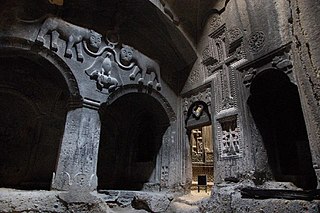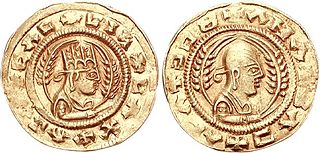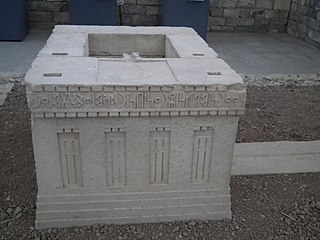
This article needs additional citations for verification .(December 2022) |
The architecture of Ethiopia varies greatly from region to region. Over the years, it has incorporated various architectural styles and techniques.

This article needs additional citations for verification .(December 2022) |
The architecture of Ethiopia varies greatly from region to region. Over the years, it has incorporated various architectural styles and techniques.

The best known building of the period in the region is the ruined 8th-century BC multi-story tower at Yeha in Ethiopia, believed to have been the capital of Dʿmt. The Temple was built by Sabaeans from modern-day Yemen during the Sabean colonization of Africa and was dedicated to the Sabean Lunar deity Almaqah. [1] Sabaen texts from Yeha mention a certain Lhy, of the Grb clan, of the family of Ygdm'I Fqmm of Marib consecrating his worldly goods and his son Hyrmh to ʿAṯtar and Almaqah. [2]

Aksumite architecture flourished in the region from the 4th century BC onward. It persisted even after the transition from the Aksumite dynasty to the Zagwe dynasty in the 12th century, as attested by the numerous Aksumite influences in and around the medieval churches of Lalibela. Stelae (hawilts) and later entire churches were carved out of single blocks of rock. This was later emulated at Lalibela and throughout the Tigray Province, especially during the early-mid medieval period (c. 10th and 11th centuries in Tigray, mainly 12th century around Lalibela). Other monumental structures include massive underground tombs, often located beneath stelae. Among the most spectacular survivals are the giant stelae, one of which, now fallen (scholars think that it may have fallen during or immediately after erection), is the single largest monolithic structure ever erected (or attempted to be erected). Other well-known structures employing the use of monoliths include tombs such as the "Tomb of the False Door" and the tombs of Kaleb and Gebre Mesqel in Axum.

Most structures, however, like palaces, villas, commoner's houses, and other churches and monasteries, were built of alternating layers of stone and wood. The protruding wooden support beams in these structures have been named "monkey heads" and are a staple of Aksumite architecture and a mark of Aksumite influence in later structures. Some examples of this style had whitewashed exteriors and/or interiors, such as the medieval 12th-century monastery of Yemrehanna Krestos near Lalibela, built during the Zagwe dynasty in Aksumite style. Contemporary houses were one-room stone structures, or two-storey square houses, or roundhouses of sandstone with basalt foundations. Villas were generally two to four storeys tall and built on sprawling rectangular plans (cf. Dungur ruins). A good example of still-standing Aksumite architecture is the monastery of Debre Damo from the 6th century.

Ethiopian architecture continued to expand from the Aksumite style, but also incorporating new traditions with the expansion of the Ethiopian state. Styles incorporated more wood and rounder structures in commoner's architecture in the center of the country and the south, and these stylistic influencies were manifested in the slow construction of churches and monasteries. Throughout the medieval period, Aksumite architecture and influences and its monolithic tradition persisted, with its influence strongest in the early medieval (Late Aksumite) and Zagwe periods (when the churches of Lalibela were carved).

Throughout the medieval period, and especially from the 10th to 12th centuries, churches were hewn out of rock throughout Ethiopia, especially during the northernmost region of Tigray, which was the heart of the Aksumite Empire. However, rock-hewn churches have been found as far south as Adadi Maryam (15th century), about 100 km south of Addis Ababa.
The most famous example of Ethiopian rock-hewn architecture are the 11 monolithic churches of Lalibela, carved out of the red volcanic tuff found around the town. They are part of the UNESCO World Heritage Site at Lalibela. [3] Though later medieval hagiographies attribute all 11 structures to the eponymous King Lalibela (the town was called Roha and Adefa before his reign), new evidence indicates that they may have been built separately over a period of a few centuries, with only a few of the more recent churches having been built under his reign. Archaeologist and Ethiopisant David Phillipson postulates, for instance, that Bete Gebriel-Rufa'el was actually built in the very early medieval period, some time between 600 and 800 A.D., originally as a fortress but was later turned into a church. [4]

During the early modern period, the absorption of new diverse influences such as Baroque, Arab, Turkish and Gujarati Indian style began with the arrival of Portuguese Jesuit missionaries in the 16th and 17th centuries. Portuguese soldiers had initially come in the mid-16th century as allies to aid Ethiopia in its fight against Adal, and later Jesuits came hoping to convert the country. Some Turkish influence may have entered the country during the late 16th century during its war with the Ottoman Empire (see Habesh), which resulted in an increased building of fortresses and castles.

Ethiopia, naturally easily defensible because of its numerous ambas or flat-topped mountains and rugged terrain, yielded little tactical use from the structures in contrast to their advantages in the flat terrain of Europe and other areas, and so had until this point little developed the tradition. Castles were built especially beginning with the reign of Sarsa Dengel around the Lake Tana region, and subsequent Emperors maintained the tradition, eventually resulting in the creation of the Fasil Ghebbi (royal enclosure of castles) in the newly founded capital (1636), Gondar. Emperor Susenyos (r.1606-1632) converted to Catholicism in 1622 and attempted to make it the state religion, declaring it as such from 1624 until his abdication; during this time, he employed Arab, Gujarati (brought by the Jesuits), and Jesuit masons and their styles, as well as local masons, some of whom were Beta Israel. With the reign of his son Fasilides, most of these foreigners were expelled, although some of their architectural styles were absorbed into the prevailing Ethiopian architectural style. This style of the Gondarine dynasty would persist throughout the 17th and 18th centuries especially and also influenced modern 19th-century and later styles.
However Gondarine architecture was limited exclusive to royalty. [5] Hassan ibn Ahmed Al Haymi, Yemeni Ambassador to Ethiopia in 1684, mentions that besides the Fasil Ghebbi the rest of Gondar was made tukuls, or huts which he describes as “nets of grass”. James Bruce states that mortar was only used in Gondar, and even there its quality was very bad. [6]

Axum, also spelled Aksum, is a town in the Tigray Region of Ethiopia with a population of 66,900 residents. It is the site of the historic capital of the Aksumite Empire.
Yeha is a town in the Maekelay Zone of the northern Tigray Region in Ethiopia. It likely served as the capital of the pre-Aksumite kingdom of D'mt.

A monolithic church or rock-hewn church is a church made from a single block of stone. Because freestanding rocks of sufficient size are rare, such edifices are usually hewn into the ground or into the side of a hill or mountain. They can be of comparable architectural complexity to constructed buildings.

The Church of Saint George is one of eleven rock-hewn monolithic churches in Lalibela, a town in the Amhara Region of Ethiopia. Originally named Roha (Warwar), the historical and religious site was named Lalibela after the King Gebre Mesqel Lalibela of the Zagwe dynasty, who commissioned its construction. He is regarded as a saint by the Ethiopian Orthodox Tewahedo Church.

Lalibela is a town in the Amhara Region of Ethiopia. Located in the Lasta district and North Wollo Zone, it is a tourist site for its famous rock-cut monolithic churches designed in contrast to the earlier monolithic churches in Ethiopia. The whole of Lalibela is a large and important site for the antiquity, medieval, and post-medieval civilization of Ethiopia. To Christians, Lalibela is one of Ethiopia's holiest cities, and a center of pilgrimage.

The Amhara Region, officially the Amhara National Regional State, is a regional state in northern Ethiopia and the homeland of the Amhara, Awi, Xamir, Argoba, and Qemant people. Its capital is Bahir Dar which is the seat of the Regional Government of Amhara. Amhara is the site of the largest inland body of water in Ethiopia, Lake Tana, and Semien Mountains National Park. Amhara is bordered by Sudan to the west and northwest and by other the regions of Ethiopia: Tigray to the north, Afar to the east, Benishangul-Gumuz to the west and southwest, and Oromia to the south. Towns and cities in Amhara include: Bahir Dar, Dessie, Gonder, Debre Birhan, Debre Tabor, Kombolcha, Weldiya, Debre Markos, Seqota, Kobo, and Metema.

The Zagwe dynasty was a medieval Agaw monarchy that ruled the northern parts of Ethiopia and Eritrea. The Agaw are a Cushitic ethnic group native to the northern highlands of Ethiopia and neighboring Eritrea. Centered at Roha, it ruled large parts of the territory from approximately 1137 to 1270 AD, when the last Zagwe King Za-Ilmaknun was killed in battle by the forces of the Amhara King Yekuno Amlak. The Zagwe are most famous for their king Gebre Mesqel Lalibela, who is credited with having ordered the construction of the rock-hewn monolithic churches of Lalibela.

The Agaw or Agew are a Cushitic ethnic group native to the northern highlands of Ethiopia and neighboring Eritrea. They speak the Agaw languages, also known as the Central Cushitic languages, which belong to the Cushitic branch of the Afroasiatic language family, and are therefore closely related to peoples speaking other Cushitic languages.

Like other aspects of the culture of Africa, the architecture of Africa is exceptionally diverse. Throughout the history of Africa, Africans have developed their own local architectural traditions. In some cases, broader regional styles can be identified, such as the Sudano-Sahelian architecture of West Africa. A common theme in traditional African architecture is the use of fractal scaling: small parts of the structure tend to look similar to larger parts, such as a circular village made of circular houses.

Rock-cut architecture is the creation of structures, buildings, and sculptures by excavating solid rock where it naturally occurs. Intensely laborious when using ancient tools and methods, rock-cut architecture was presumably combined with quarrying the rock for use elsewhere. Though, in India and China, the terms cave and cavern are often applied to this form of man-made architecture, caves and caverns that began in natural form are not considered to be rock-cut architecture even if extensively modified. Although rock-cut structures differ from traditionally built structures in many ways, many rock-cut structures are made to replicate the facade or interior of traditional architectural forms. Interiors were usually carved out by starting at the roof of the planned space and then working downward. This technique prevents stones falling on workers below. The three main uses of rock-cut architecture were temples, tombs, and cave dwellings.

Lalibela, regnal name Gebre Meskel, was a king of the Zagwe dynasty, reigning from 1181 to 1221. He was the son of Jan Seyum and the brother of Kedus Harbe. Perhaps the best-known Zagwe monarch, he is credited as the patron of the namesake monolithic rock-hewn churches of Lalibela. He is venerated as a saint by the Ethiopian Orthodox Tewahedo Church on 19 June.

Tigray Province, also known as Tigre, was a historical province of northern Ethiopia that overlayed the present day Afar and Tigray regions. Akele Guzai borders with the Tigray province. It encompassed most of the territories of Tigrinya-speakers in Ethiopia. Tigray was separated from the northern Tigrinya speaking territories by the Mareb River, now serving as the state border to Eritrea, bordering Amhara region in the south.

Ethiopia is one of the oldest countries in Africa; the emergence of Ethiopian civilization dates back thousands of years. Abyssinia or rather "Ze Etiyopia" was ruled by the Semitic Abyssinians (Habesha) composed mainly of the Amhara, Tigrayans and the Cushitic Agaw. In the Eastern escarpment of the Ethiopian highlands and more so the lowlands were the home of the Harari/Harla that founded Sultanates such as Ifat and Adal and the Afars. In the central and south were found the ancient Sidama and Semitic Gurage, among others.

The Kingdom of Aksum also known as the Kingdom of Axum, or the Aksumite Empire, was a kingdom in East Africa and South Arabia from classical antiquity to the Middle Ages. Based in what is now northern Ethiopia and Eritrea, and spanning present-day Djibouti and Sudan, it extended at its height into much of South Arabia during the reign of Kaleb of Axum.

Biete Maryam is one of the monolithic rock-cut Rock-Hewn Churches, Lalibela of the Ethiopian Orthodox Tewahedo Church. It is part of the UNESCO World Heritage Site at Lalibela.

Adadi Mariam is a rock-hewn monolithic church located approximately 66 km southwest of Addis Ababa, Ethiopia. A popular tourist destination, the site is believed to have been built in the 12th century.

The eleven Rock-hewn Churches of Lalibela are monolithic churches located in the western Ethiopian Highlands near the town of Lalibela, named after the late-12th and early-13th century King Gebre Meskel Lalibela of the Zagwe dynasty, who commissioned the massive building project of 11 rock-hewn churches to recreate the holy city of Jerusalem in his own kingdom. The site remains in use by the Ethiopian Orthodox Christian Church to this day, and it remains an important place of pilgrimage for Ethiopian Orthodox worshipers. It took 24 years to build all the 11 rock hewn churches.

The history of Ethiopia in the Middle Ages roughly spans the period from the decline of the Kingdom of Aksum in the 7th century to the Gondarine period beginning in the 17th century. Aksum had been a powerful empire during late antiquity, appearing in the Periplus of the Erythraean Sea and mentioned by Iranian prophet Mani as one of the "four great kingdoms on earth", along with the Sasanian Empire of Persia, the Roman Empire, and China's Three Kingdoms. The kingdom was an integral part of the trade route between Rome and the Indian subcontinent, had substantial cultural ties to the Greco-Roman world, and was a very early adopter of Christianity under Ezana of Aksum in the mid-4th century. The use of "Ethiopia" to refer to the region dates back to the 4th century. At its height, the kingdom spanned what is now Eritrea, northern Ethiopia, eastern Sudan, Yemen and the southern part of what is now Saudi Arabia. However, by the 7th century, the kingdom had begun a slow decline, for which several possible political, economic, and ecological reasons have been proposed. This decline, which has been termed the "Post-Aksumite Period", saw extreme loss of territory and lasted until the ascension of the Zagwe dynasty.

The Gondarine period was a period of Ethiopian history between the ascension of Emperor Fasilides in 1632 and a period of decentralization in 1769, known as the Zemene Mesafint.

The Temple of Meqaber Gaʿewa near Wuqro in Tigray Region, Ethiopia is dedicated to the lunar God Almaqah, and contains an altar which represents a miniature model of the Great Temple in Yeha.